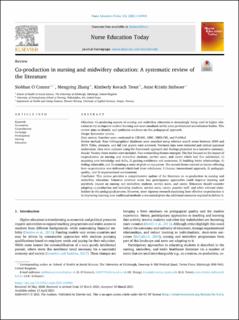| dc.contributor.author | O'Connor, Siobhan | |
| dc.contributor.author | Zhang, Mengying | |
| dc.contributor.author | Trout, Kimberly Kovach | |
| dc.contributor.author | Snibsøer, Anne Kristin | |
| dc.date.accessioned | 2021-10-20T13:33:19Z | |
| dc.date.available | 2021-10-20T13:33:19Z | |
| dc.date.created | 2021-04-14T08:53:57Z | |
| dc.date.issued | 2021 | |
| dc.identifier.citation | O'Connor, S., Zhang, M., Trout, K. K., & Snibsoer, A. K. (2021). Co-production in nursing and midwifery education: A systematic review of the literature. Nurse Education Today, 102, 104900. | en_US |
| dc.identifier.issn | 0260-6917 | |
| dc.identifier.uri | https://hdl.handle.net/11250/2824199 | |
| dc.description.abstract | Objectives
Co-producing aspects of nursing and midwifery education is increasingly being used in higher education to try to improve student learning and meet standards set by some professional accreditation bodies. This review aims to identify and synthesise evidence on this pedagogical approach.
Design
Systematic review.
Data sources
Searches were conducted in CINAHL, ERIC, MEDLINE, and PubMed.
Review methods
Four bibliographical databases were searched using relevant search terms between 2009 and 2019. Titles, abstracts, and full text papers were screened. Pertinent data were extracted and critical appraisal undertaken. Data were analysed using the framework approach and findings presented in a narrative summary.
Results
Twenty-three studies were included. Two overarching themes emerged. The first focused on the impact of co-production on nursing and midwifery students, service users, and carers which had five subthemes; 1) acquiring new knowledge and skills, 2) gaining confidence and awareness, 3) building better relationships, 4) feeling vulnerable, and 5) attaining a sense of pride or enjoyment. The second theme centred on factors affecting how co-production was delivered which had three subthemes; 1) human interactional approach, 2) pedagogic quality, and 3) organisational environment.
Conclusion
This review provides a comprehensive update of the literature on co-production in nursing and midwifery education. Tentative evidence exists that participatory approaches could improve learning and positively impact on nursing and midwifery students, service users, and carers. Educators should consider adopting co-production and including students, service users, carers, practice staff, and other relevant stakeholders in this pedagogical process. However, more rigorous research examining how effective co-production is in improving learning over traditional methods is warranted given the additional resources required to deliver it. | en_US |
| dc.language.iso | eng | en_US |
| dc.publisher | Elsevier | en_US |
| dc.rights | Navngivelse 4.0 Internasjonal | * |
| dc.rights.uri | http://creativecommons.org/licenses/by/4.0/deed.no | * |
| dc.title | Co-production in nursing and midwifery education: A systematic review of the literature | en_US |
| dc.type | Peer reviewed | en_US |
| dc.type | Journal article | en_US |
| dc.description.version | publishedVersion | en_US |
| dc.rights.holder | © 2021 The Authors. | en_US |
| dc.subject.nsi | VDP::Medisinske Fag: 700::Helsefag: 800 | en_US |
| dc.source.volume | 102 | en_US |
| dc.source.journal | Nurse Education Today | en_US |
| dc.identifier.doi | 10.1016/j.nedt.2021.104900 | |
| dc.identifier.cristin | 1903907 | |
| dc.source.articlenumber | 104900 | en_US |
| cristin.ispublished | true | |
| cristin.fulltext | original | |
| cristin.qualitycode | 1 | |

